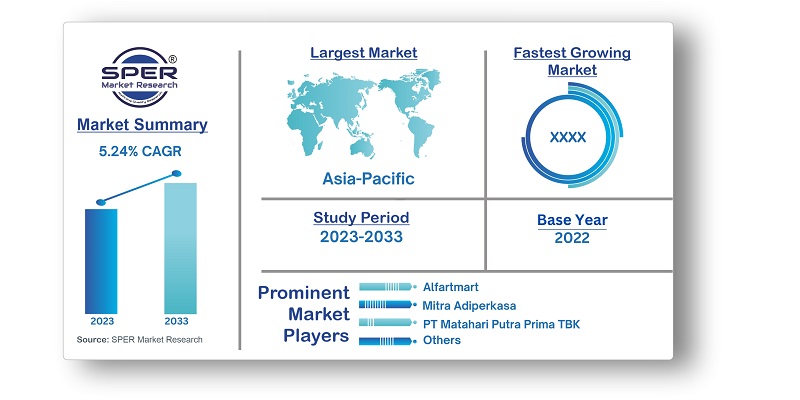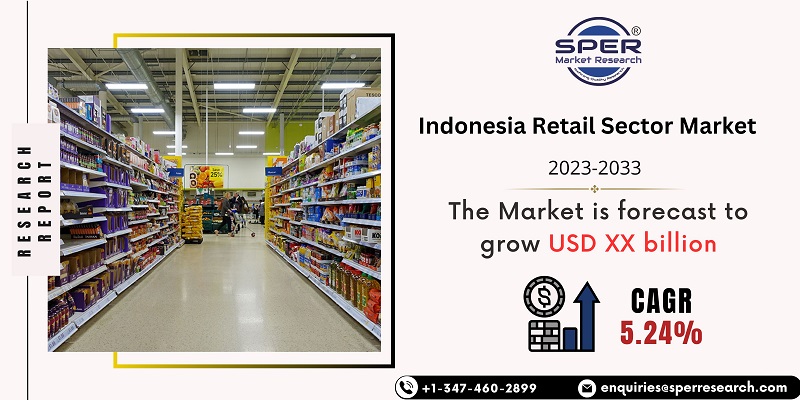
Indonesia Retail Sector Market Growth, Size, Trends, Revenue, Scope, Challenges and Future Share
Indonesia Retail Sector Market Size- By Product, By Distribution Channel- Regional Outlook, Competitive Strategies and Segment Forecast to 2033
| Published: Aug-2023 | Report ID: FMCG2392 | Pages: 1 - 109 | Formats*: |
| Category : Consumer & Retail | |||
- Good Economic Growth: Indonesia's good economic performance has contributed to the retail sector's expansion. Rising income levels and a growing middle class have driven consumer spending, driving demand for a wide range of goods and services.
- Middle-Class Expansion: As the middle class grows, customers have more disposable income, which leads to higher spending on discretionary items, luxury goods, and experiences. This demographic change has offered opportunity for luxury and specialty retailers.


| Report Metric | Details |
| Market size available for years | 2019-2033 |
| Base year considered | 2022 |
| Forecast period | 2023-2033 |
| Segments covered | By Product, By Distribution Channel |
| Regions covered | Northern Region, Southern Region, Western Region, Eastern Region |
| Companies Covered | Alfartmart, Mitra Adiperkasa, PT Matahari Putra Prima TBK, PT Trans Retail Indonesia, Ramayana Lestari Sentosa, Others |
- Middle-Class Consumers
- Urban Dwellers
- Young Professionals
- Tourists
- Low-Income Consumers
| By Product: | |
| By Distribution Channel: |
- Indonesia Retail Sector Market Size (FY’2023-FY’2033)
- Overview of Indonesia Retail Sector Market
- Segmentation of Indonesia Retail Sector Market By Product (Apparel, Footwear and Accessories, Electronic and Household Appliances, Food and Beverages, Furniture, Toys and Hobby, Personal and Household Care, Others)
- Segmentation of Indonesia Retail Sector Market By Distribution Channel (Convenience Stores, Department Stores, Supermarkets and Hypermarkets. others)
- Statistical Snap of Indonesia Retail Sector Market
- Expansion Analysis of Indonesia Retail Sector Market
- Problems and Obstacles in Indonesia Retail Sector Market
- Competitive Overview in the Indonesia Retail Sector Market
- Impact of COVID-19 and Demonetization on Indonesia Retail Sector Market
- Details on Current Investment in Indonesia Retail Sector Market
- Competitive Analysis of Indonesia Retail Sector Market
- Prominent Players in the Indonesia Retail Sector Market
- SWOT Analysis of Indonesia Retail Sector Market
- Indonesia Retail Sector Market Future Outlook and Projections (FY’2023-FY’2033)
- Recommendations from Analyst
1.1. Scope of the report1.2. Market segment analysis
2.1. Research data source2.1.1. Secondary Data2.1.2. Primary Data2.1.3. SPER’s internal database2.1.4. Premium insight from KOL’s2.2. Market size estimation2.2.1. Top-down and Bottom-up approach2.3. Data triangulation
4.1. Driver, Restraint, Opportunity and Challenges analysis4.1.1. Drivers4.1.2. Restraints4.1.3. Opportunities4.1.4. Challenges4.2. COVID-19 Impacts of the Indonesia Retail Sector Market
5.1. SWOT Analysis5.1.1. Strengths5.1.2. Weaknesses5.1.3. Opportunities5.1.4. Threats5.2. PESTEL Analysis5.2.1. Political Landscape5.2.2. Economic Landscape5.2.3. Social Landscape5.2.4. Technological Landscape5.2.5. Environmental Landscape5.2.6. Legal Landscape5.3. PORTER’s Five Forces5.3.1. Bargaining power of suppliers5.3.2. Bargaining power of buyers5.3.3. Threat of Substitute5.3.4. Threat of new entrant5.3.5. Competitive rivalry5.4. Heat Map Analysis
6.1. Indonesia Retail Sector Market Manufacturing Base Distribution, Sales Area, Product Type6.2. Mergers & Acquisitions, Partnerships, Product Launch, and Collaboration in Indonesia Retail Sector Market
7.1. Indonesia Retail Sector Market Value Share and Forecast, By Product, 2023-20337.2. Apparel, Footwear and Accessories7.3. Electronic and Household Appliances7.4. Food and Beverages7.5. Furniture, Toys and Hobby7.6. Personal and Household Care7.7. Others
8.1. Indonesia Retail Sector Market Value Share and Forecast, By Distribution Channel, 2023-20338.2. Convenience Stores8.3. Department Stores8.4. Supermarkets and Hypermarkets8.5. Others
9.1. Indonesia Retail Sector Market Size and Market Share
10.1. Indonesia Retail Sector Market Size and Market Share By Product (2019-2026)10.2. Indonesia Retail Sector Market Size and Market Share By Product (2027-2033)
11.1. Indonesia Retail Sector Market Size and Market Share By Distribution Channel (2019-2026)11.2. Indonesia Retail Sector Market Size and Market Share By Distribution Channel (2027-2033)
12.1. Indonesia Retail Sector Market Size and Market Share By Region (2019-2026)12.2. Indonesia Retail Sector Market Size and Market Share By Region (2027-2033)12.3. Northern Region12.4. Southern Region12.5. Eastern Region12.6. Western Region
13.1. Alfartmart13.1.1. Company details13.1.2. Financial outlook13.1.3. Product summary13.1.4. Recent developments13.2. Mitra Adiperkasa13.2.1. Company details13.2.2. Financial outlook13.2.3. Product summary13.2.4. Recent developments13.3. PT Matahari Putra Prima Tbk13.3.1. Company details13.3.2. Financial outlook13.3.3. Product summary13.3.4. Recent developments13.4. PT Trans Retail Indonesia13.4.1. Company details13.4.2. Financial outlook13.4.3. Product summary13.4.4. Recent developments13.5. Ramayana Lestari Sentosa13.5.1. Company details13.5.2. Financial outlook13.5.3. Product summary13.5.4. Recent developments13.6. Others
SPER Market Research’s methodology uses great emphasis on primary research to ensure that the market intelligence insights are up to date, reliable and accurate. Primary interviews are done with players involved in each phase of a supply chain to analyze the market forecasting. The secondary research method is used to help you fully understand how the future markets and the spending patterns look likes.
The report is based on in-depth qualitative and quantitative analysis of the Product Market. The quantitative analysis involves the application of various projection and sampling techniques. The qualitative analysis involves primary interviews, surveys, and vendor briefings. The data gathered as a result of these processes are validated through experts opinion. Our research methodology entails an ideal mixture of primary and secondary initiatives.



Frequently Asked Questions About This Report
PLACE AN ORDER
Year End Discount
Sample Report
Pre-Purchase Inquiry
NEED CUSTOMIZATION?
Request CustomizationCALL OR EMAIL US
100% Secure Payment






Related Reports
Our Global Clients
Our data-driven insights have influenced the strategy of 200+ reputed companies across the globe.




















